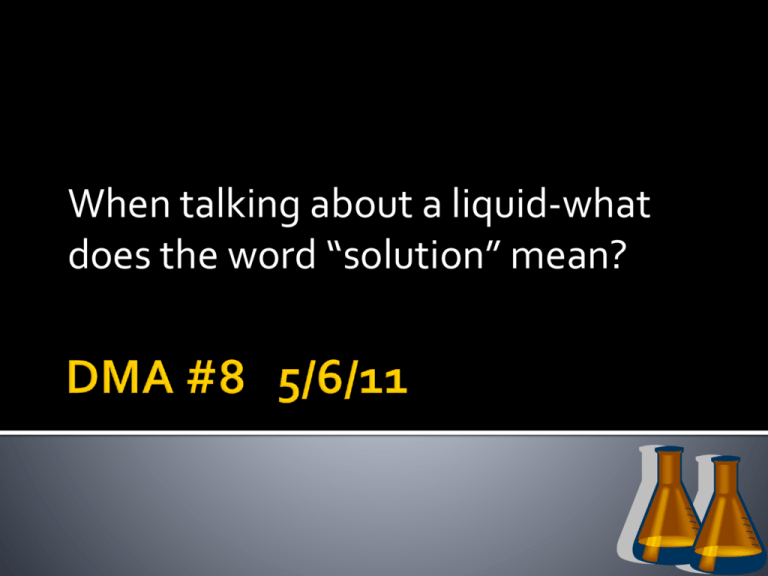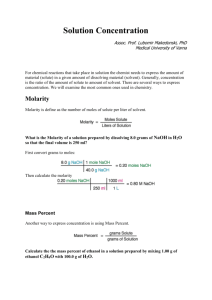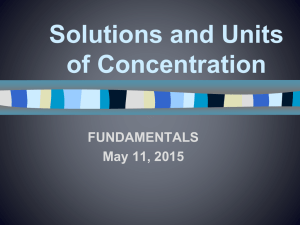Unit 8 Solutions Notes unit_8
advertisement

When talking about a liquid-what does the word “solution” mean? A homogeneous mixture of two or more substances in a single physical state Liquid Solid Gas Solutions are homogeneous mixtures A solute is the dissolved substance in a solution. Salt in salt water Sugar in soda drinks Carbon dioxide in soda drinks Solvent A solvent is the dissolving medium in a solution. Water in salt water Water in soda Solubility can apply to different states of matter. Ability to dissolve. Soluble – a substance that is able to dissolve in another substance. Sugar in water Salt in water Insoluble – A substance that does not dissolve in another substance. Oil in water Solid solutions Alloys – two or more metals Gaseous solutions Air Liquid solutions Oxygen in water Vinegar (acetic acid in water) Aqueous solutions Ions in water Nonpolar solutes dissolve best in nonpolar solvents Fats Steroids Waxes Benzene Hexane Toluene Polar and ionic solutes dissolve best in polar solvents Inorganic Salts Sugars Water Small alcohols Acetic acid Solids tend to dissolve best when: o Heated o Stirred o Ground into small particles Liquids tend to dissolve best when: o The solution is cold o Pressure is high A solution that contains the maximum amount of solute that may be dissolved under existing conditions is saturated. A solution that contains less solute than a saturated solution under existing conditions is unsaturated. A solution that contains more dissolved solute than a saturated solution under the same conditions is supersaturated. Do the following in your notebooks: 15-1 Section Review questions #1-4, pg. 505 On pg. 532 do the “Concept Mapping” activity What is a solute and what is a solvent? The concentration of a solution is the amount of solute in a given amount of solvent or solution. Molarity - the ratio of moles of solute to liters of solution Molarity=M= moles of solute Liters of solution You need to be able to calculate molarity Example: What is the molarity of a solution formed by mixing 10.0g H2SO4 with enough water to make 100.0mL of solution? To solve: Moles of solute? ▪ 10.o g H2SO4 Liters of solution? ▪ 100.0mL How do we solve it? convert our units Divide solute by solution’s total volume mL L Gramsmoles 10.0g H2SO4 x 1mol H2SO4 0.100 L solution 98.1 g H2SO4 Answer 1.02 M Practice #1 Vinegar is a solution of acetic acid. What is the molarity of the solution when 125 g of acetic acid (C2H4O2) is dissolved in enough water to make 1.50 L of solution? Answer 1.39M Practice #2 How many grams of bromine are needed to prepare 0.500 L of a 0.0100 M solution of bromine in water? Answer 0.799 g To learn more about molarity and how to calculate it we will be doing a lab! Beer’s Law (named after a person, not a beverage) states that you can determine the concentration of a solution by how much light it absorbs. So, you will be making solutions of different concentrations and testing them Important to remember Your measurements and calculations must be exact! If you do not measure right, you will ruin your solution and you will have to begin again You will do a graph-this MUST be done on graph paper or by computer-NO exceptions Mole fraction – the ratio of moles of solute to total moles of solution nA Mole fraction of A A n A nB Calculate the Molarity of 98 grams of sodium hydroxide in 2.2 liters of solution. Getting started: Create a data table Make up your solution This is from the calculations you made yesterday 50 mL total You will use this to create all the dilutions T0 make your dilutions: M1V1=M2V2 After you create the dilutions you will place a sample of your solution in the colorimeter You will graph your results-on graph paper









